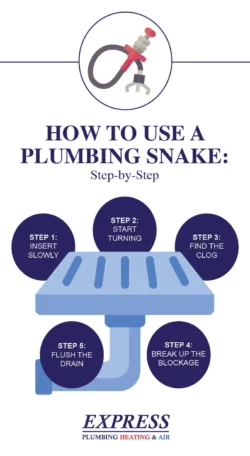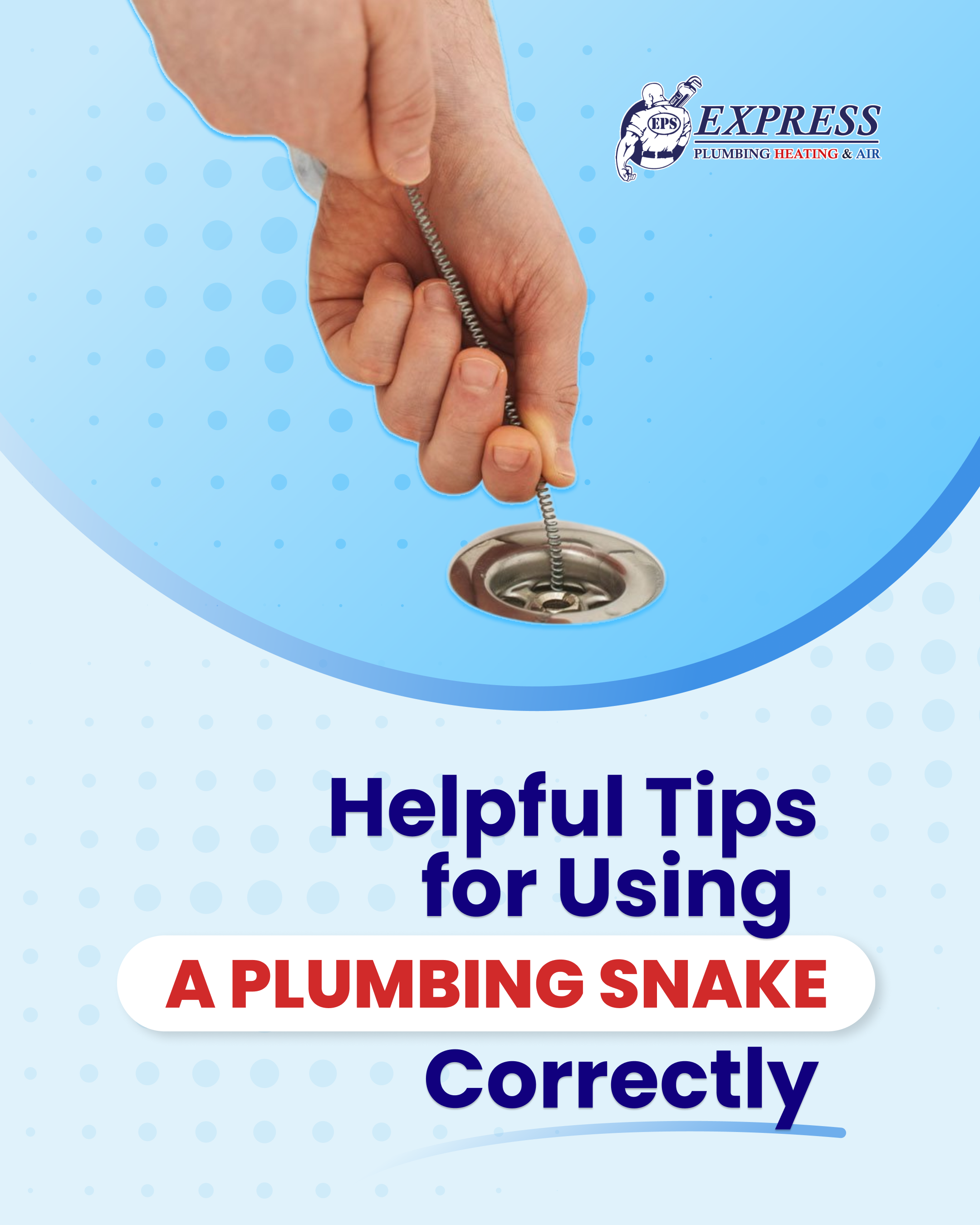If you’re a homeowner here in the Boise, ID area, there’s a good chance you’ve had to deal with a clogged pipe at least once. Fortunately, knowing how to use a plumbing snake correctly can help you remove clogs when the situation arises.
A plumbing snake is a common tool for cleaning clogged drains, but using it properly is important to avoid pipe damage. The team at Express Plumbing, Heating, and Air has some plumbing snake tips and tricks for homeowners, renters, and DIYers about the best way to use this device.
What Is a Plumbing Snake and How Does It Work?
A plumbing snake, also called a drain snake, is a device used to unclog plumbing pipes. It’s available in a handheld design with an enclosed spool made of a thick metal cable that’s typically 25 or 50 feet long. A helix-shaped coiled hook is at the outermost part of the cable, which comes into contact with the clog and shreds it into smaller pieces as you move it through the interior drains in your home.
While a plumbing snake is something every homeowner in Boise should have in their toolbox to handle clogs, it’s not the same as a plunger or chemical cleaner. A plunger creates a vacuum seal over the opening of a drain, pushing water down to dislodge a clog. Chemical cleaners contain ingredients formulated to break up waste and clogs that can then be flushed down the drain.
Types of plumbing snakes
An important part of drain snaking for beginners is understanding the different types available:
- Hand-cranked plumbing snakes: A hand-cranked plumbing snake includes a long cable coiled inside a drum. The cable travels through the pipe until it reaches the clog, then rotates until it catches the clog and pulls the blockage away. Next, the snake is pulled out or cranked back up out of the pipe to remove the cause of the clog.
- Motorized drain augers: A motorized drain auger is more powerful than a hand-cranked snake because it uses a motor to push the cable into the drain. Most motorized augers are used to access plumbing from the outside rather than the inside of your home.
- Toilet augers vs. standard drain snakes: A drain auger features a larger spool and is used by licensed plumbing professionals to access household plumbing via the exterior through the main sewer line. The plumber may attach a camera to the auger to identify the location and cause of the clog. Drain augers have much larger spools and come in a variety of cable widths.
Choosing the right type for different clogs
Before you try to unclog your drain with a drain snake, it’s important to note that different types should be used for different clogs.
- Basic handheld drain snakes remove minor clogs in sinks and tubs, while a toilet snake is best for a clogged toilet to prevent damaging the porcelain.
- A motorized auger is ideal for larger, more stubborn clogs in your home’s drain lines and/or sewer system and should only be used by a licensed plumber.
- The cable diameter should fit your pipes. Cables that are too large can get stuck in your pipes and cause damage. The length should also be adequate to reach the clog.
- Make sure the snake or auger you use is designed to work with your specific type of pipes, whether they’re made of PVC or metal.
How To Prepare Before Using a Plumbing Snake
The best way to snake a drain is to start by finding and removing the P-trap. Most P-traps are screwed on by hand and are easy to remove with your fingers or an adjustable wrench. Remove it over a bucket or towel to collect excess water, then follow these steps before using the plumbing snake.
- Assess the clog: Foul odors coming from your drains, gurgling drains, or slow drainage may indicate the clog is shallow enough to be removed with a plumbing snake. Try using a plunger or pouring boiling water down the drain first to see if that does the trick.
- Gather tools and safety gear: If you decide to use a plumbing snake, you’ll need a pair of gloves, eye protection, a bucket, towels, and rags to clean up the potential mess. Once you’re done, add a drain screen to prevent future clogs.
- Check pipes for compatibility: Older, fragile pipes can break or crack if a plumbing snake is used incorrectly. Metal and plastic pipes may also need different handling techniques. If you’re too rough, the metal pipes may corrode, and plastic or PVC pipes can become scratched or warped.
Step-by-Step Guide To Using a Plumbing Snake Correctly
Here’s a step-by-step DIY drain snaking guide to help you use a plumbing snake correctly:
- Step one: Insert the plumbing snake into the drain slowly to prevent pipe damage. Don’t turn the handle yet because the snake needs to maneuver around any bends or corners of your pipes.
- Step two: Turn the handle clockwise slowly to rotate the cable once the snake has gone several inches into the drain. Be aware of any resistance. If you can’t get it past the bend, reverse the handle to turn it back toward you, which forces the head end to move back and forth until it finds the correct angle.
- Step three: Navigate bends and blockages by slowly feeling for the clog. If you hit a bend or corner, try to move the snake to the opposite side of the pipe and continue turning the handle until it moves again. If you can’t go any further, you’ve reached the clog.
- Step four: Break up the clog by turning the snake at the highest speed possible, letting it spin for a few minutes. If it stops turning, tighten the thumbscrew, the component that locks the cable in place. If the blockage is still stubborn, retract and try again.
- Step five: Once the clog is broken up, pull the snake out of the drain and run hot water to clear out any leftover debris. You can also pour a clog-clearing solution down the drain to remove excess debris.
Troubleshooting Common Plumbing Snake Issues
Using a plumbing auger correctly is key to preventing damage to your pipes. Here’s how to troubleshoot some common plumbing snake issues:
- Won’t go down the drain: If the snake won’t go down the drain, it may be due to tight bends or a large, solid blockage. Adjust the angle of the snake, pull it out, and try again, or consider using a different tool or hiring a professional plumber.
- Snake gets stuck in the drain: Gently rotate the handle and pull the snake back slowly if it gets stuck in the drain. You can also turn it in both directions while applying slight pressure or push it forward, then gently pull it back again. Contact a plumber if you can’t get the snake to go any further or remove the clog.
- Drain still clogged: If your drain is still clogged, partially clogged, or there’s a deeper blockage, you may need professional assistance. A licensed plumber can use a process called hydrojetting or a motorized auger to remove larger, more stubborn blockages.
Contact Express Plumbing Today
Knowing how and when to use a plumbing snake is key to protecting your plumbing and removing clogs safely. When in doubt, the team at Express Plumbing is available to help you tackle the toughest clogs in your Boise area home. If you need plumbing repair, maintenance, or other services we provide, contact us today!




